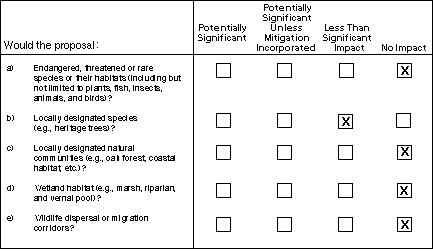
VII. BIOLOGICAL RESOURCES

The two existing substation sites, Eagle Rock Substation and Fulton Substation, consisting of compacted dirt and asphalt, respectively, do not provide any habitat values for common wildlife species. Therefore, no impacts to special status plant and wildlife species nor their habitats will occur from the facilities development at either of these two stations. One pole, as part of the power line extension from Unit 11 to Eagle Rock, will be placed within a graded area just westerly of the Unit 11 substation area and will not affect any wildlife habitat or vegetation community. Two poles would be placed on sites proposed to be graded for access roads to be located on naturally vegetated slopes, west of PG&E Unit 11. Plant surveys, specifically for (Cryptantha clevelandii ssp. dissita), identified in the PEA as potentially occurring on site, and for other rare, threatened, and endangered species, as well as those species under review by the California Native Plant Society, were conducted by Dr. D.W. Taylor on June 22, 1998. The area surveyed included all potentially affected sites in the vicinity of the proposed transmission line, including the alignment of the transmission corridor, each individual pole site, existing and proposed access roads, and large (previously graded) lay down areas adjacent to the sub-station and nearby steam wells. No sensitive species were reported. Neither special status plant or wildlife species nor their habitats occur within the proposed project site, and therefore no impact would occur.
There is potential for raptors to be nesting in the large trees adjacent to the Fulton Substation, although no raptors or nests were observed during field surveys. To avoid potential harassment of nesting raptors from construction activities, PG&E has proposed that preconstruction raptor surveys shall be conducted, and if nests or raptors are observed, construction shall be rescheduled to avoid the raptor nesting season. Additional mitigation is not required. The impact would be less than significant.
TOP
| Forward to Next Section (Energy and Mineral Resources) |
Back to Previous Section (Transportation and Circulation) |
Back to Northern Geysers Reinforcement Project Main Page | CPUC Environmental Page | CPUC Home Page |